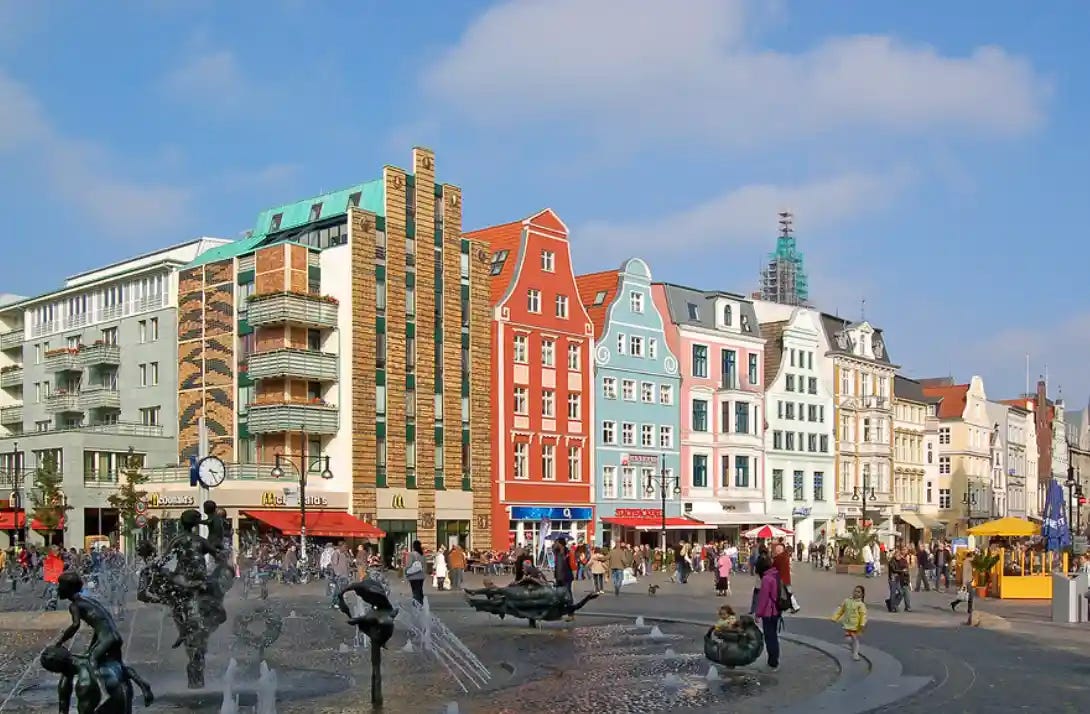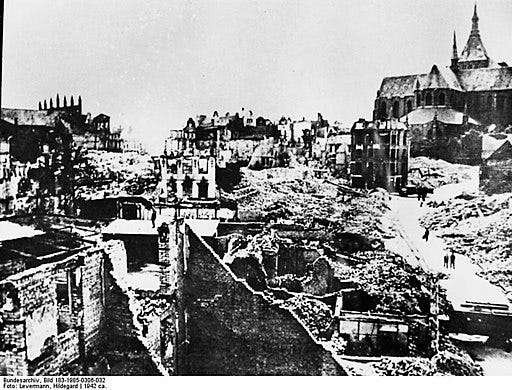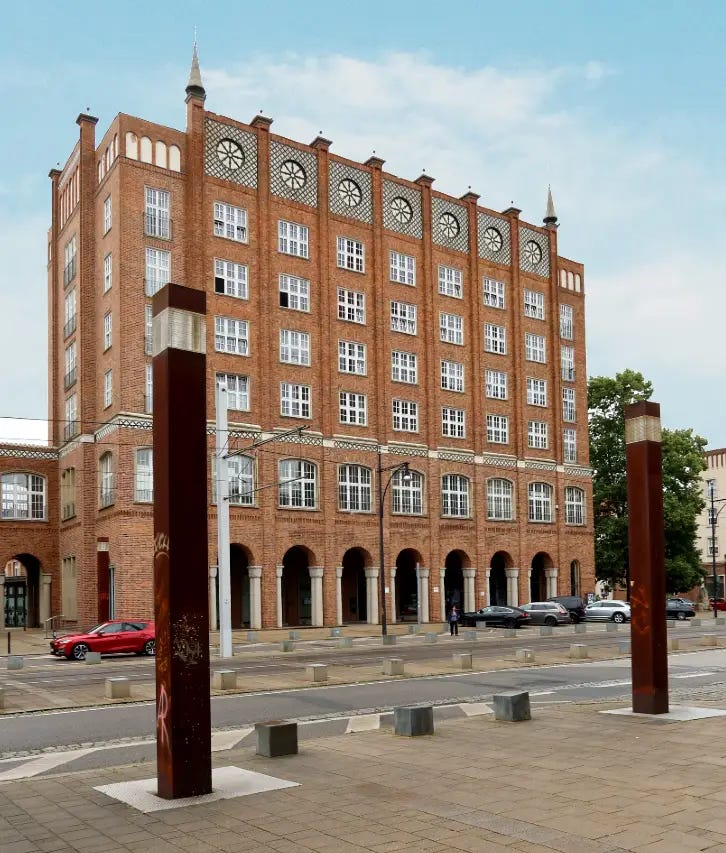The Lange Straße in Rostock: DDR architecture on the Baltic Sea.
Once upon a time, there were great socialist roads: imposing, oversized, symbolic. Rostock is home to one of the most beautiful and least known.
For many Berliners, Rostock is the gateway to the Warnemünde beach. At 14 kilometres long, this beach is the largest on the Baltic Sea and can be easily reached from the metropolis in less than three hours by train. Due to the changing weather conditions along the Baltic coast, it is sometimes necessary to take a break from the sea to explore the nearest city. A walk of a few hours is enough to reveal the beauty of Rostock to tourists: perhaps not as romantic as Wismar or Stralsund, but just as historically relevant.
Rostock, Hanseatic City.
Rostock is a Hanseatic city with a long history. Its port made it an important economic centre and as early as 1419 it had its own university, still one of the most prestigious in the former East Germany. With a population of almost 210,000, slightly more than that of Trieste, Rostock is the most populous city in Mecklenburg-Vorpommern.
During the Nazi regime, Rostock played a very important role. Both warships and merchant ships were built in the city, and the chemical and metallurgical industries were important. Its harbour was a crucial transit point for goods coming in and out of Germany, as well as a naval base of the Kriegsmarine (the navy) well connected to the different directions of the empire, used for the transport of troops and supplies.
This importance condemned the city to suffer one of the most devastating bombings of the Second World War. Between 23 and 27 April 1942, almost five hundred planes of the British Royal Air Force dropped more than one hundred thousand bombs on Rostock, killing thousands of civilians and destroying more than half of the old town centre.
The political value of reconstruction.
In the immediate aftermath of the war, reconstruction was a priority in both parts of the country, in the Western Allies-occupied west and in the Soviet-controlled east.
But the problem was: what to rebuild first, how to do it and with what resources? The Federal Republic of Germany (West Germany) and the Democratic Republic of Germany (East Germany) had very different priorities and approaches.
For the nascent GDR, reconstruction was also an opportunity to prove that it was 'the better Germany'. Social housing was not sufficient for this purpose. On the contrary, urgent housing needs often took second place. New symbols were wanted: majestic streets modelled on Moscow architecture - this was the case with Berlin's Stalinallee (today's Karl-Marx-Allee) - or historic centres, where the old identity could be restored as far as possible. Or to create a new and original one.
The latter model was adopted for the reconstruction of Rostock, mixing elements inspired by Hanseatic architecture with touches of Soviet monumental classicism. The historic city centre, which had been wiped clean except for the miraculously preserved St Mary's Church, offered the ideal space for something imposing.
The old Lange Strasse, which ran from the Marienkirche to cut the old town in two, no longer existed. A new 'long street' was to surpass the old one in size and monumentality.
Urban architecture: an obsession of Walter Ulbricht.
The 'Nationales Aufbauwerk' ('National Reconstruction Work') was a key programme for Walter Ulbricht, the first chairman of the GDR Council of Ministers and head of the SED, the single socialist party.
Ulbricht was obsessed with architecture as a means of communication and an instrument to forge a new national identity. For this reason, despite the fact that the most urgent need was the construction of residential quarters for the millions of people who had been left homeless after the bombings and for refugees arriving from the lost provinces, Ulbricht gave the mandate to focus on representative buildings and streets (the 'magisterial streets') that were to glorify the socialist state and express the new social order.
Berlin, Dresden, Leipzig, Dessau, Chemnitz and Rostock were to be representative cities of the new Germany, with streets where large mass demonstrations could be organised.
On the last Friday in January 1953, Ulbricht laid the foundation stone of the new road construction site and harangued the workers crowded under the stage from which he spoke:
"Start working! Build a more beautiful Rostock!".
In the following months Ulbricht personally inspected the plans of the Rostock architects. It is the head of the SED who asks for the street to be three times as wide as the original one, for a width of sixty metres. For the houses, which are to become 'people's palaces', a maximum height of five storeys is planned, plus a couple of taller buildings at the beginning and end of the street.
A mix of Hanseatic Gothic and the 'Heimatschutz' architecture of the Weimar years.
Anyone visiting both Karl-Marx-Allee in Berlin and Lange Straße in Rostock today will immediately notice the difference: the former looks as if it had been dropped in from Moscow. The latter, to those unfamiliar with German architectural history, looks strange and very 'decorative'.
In fact, Lange Straße is a mix of styles, with the ambition of being a bit of a thoroughfare and a bit of a park to stroll in, embellished with faux-medieval stelae.
The Gothic-style red-brick buildings evoke the history of the glorious Hanseatic city: in front, wide pavements and a green area - later replaced by tram tracks, still present today - designed to create an urban idyll. The friezes of these buildings are inspired by the ornamental gables of the town halls of Lübeck, Rostock and Stralsund.
The other important part of the Lange Straße project, however, comes from the repertoire of 'Heimatschutz Architecture', created in the 1920s and 1930s. These are architectural and urban planning elements that evoke the impression of sandstone worked by a stonemason and enhance the brick façades; these elements, of Romanesque derivation, are exogenous to the Baltic tradition, as are the arcades, so familiar to us Italians.
The Heimatschutz style, developed during the Weimar Republic, took different elements and mixed them into constructions with an antique flavour. The effect is somewhat fictitious, but pleasing.
The symbol of a new society mixing classes.
The street was built in record time. In April 1954, the first tenants moved into the comfortable flats on the "Straße des Nationalen Aufbauwerks", as it was officially called from 20 June 1953.
Who are these lucky people? Workers rewarded for their hard work, craftsmen, but also doctors and university professors. Strictly chosen by the Party, with the intention of creating a new 'socialist community of people'.
A total of 433 flats, 35 shops, a department store, a kindergarten, several restaurants, a house of the 'Freie Deutsche Jugend', the communist youth, and a library are planned.
Year after year, however, they were forced to change construction plans and go downwards: less expensive materials, fewer decorative details. Even the name changes, reverting to the historic 'Lange Straße', long street.
Many love this new monumental street. But older residents and town planners soon observe that, besides being oversized, this street ends up separating a piece of the historic city from its harbour and the northern part of the historic city, which is in fact forgotten and remains dilapidated until the 1980s.
In the following years, all the biggest demonstrations and processions passed through here: 1 May, of course, but also - in 1980 - the first Cuban carnival organised by the community of workers from that country.
Finally, in 1989, representatives of the civil rights movement demanding free elections and democracy marched along Lange Strasse.
With the 1990s, buildings and houses on Lange Strasse are being renovated. In 2020, a pilot project uses the wide lanes to lay out a beautiful Fahrradstrasse, a cycle path worthy of the streets of Amsterdam.
The Lange Straße today: a street to walk along, but not to walk on.
Today, cyclists, trams and cars coexist in the Lange Straße, more peacefully than in Berlin. The street is lined with a few, small shops, a couple of sports stores and a branch of the Galeria department store. There are only a few cafés and restaurants: the shopping centre and the hustle and bustle are the pedestrianised Kròpeliner Strasse and the Neuer Markt square, separated from Lange Strasse by the Marienkirche.
The Lange Strasse is a street where one passes, but does not stroll. Ulbricht's ambition to make it an iconic place and an attraction to visit has not been realised.
It is a fate common to other great socialist streets of the GDR: Berlin's Karl-Marx-Allee, after its rediscovery in the 1990s, is often ignored by tourists visiting the city; so are other great streets of socialist architecture. One may walk past them, look at them absent-mindedly. Many cannot distinguish what was built before, what after. Perhaps, who knows, they are not Instagrammable enough.
Instead, Rostock's architectural mix is worth a day's stroll, whatever the time of year. YouTube overflows with little videos introducing the city: for the curious, there is no shortage of videos reminiscent of Rostock in the sixties and seventies.
Post-scriptum: the shadows of Rostock.
For many Germans, however, Rostock is not the Hanseatic city of ambitious architecture, prestigious universities and interesting small museums. In the collective memory of the reunited country, Rostock entered in the worst way in 1992.
On 22 August of that year, a group of people led by neo-Nazis attacked the reception centre for asylum seekers and a hostel for former Vietnamese contract workers (Gastarbeiter) in the district of Rostock-Lichtenhagen, amidst thousands of cheering spectators in what became a veritable pogrom that lasted four days: the police, humiliated and perhaps complicit, even withdrew, leaving one hundred Vietnamese trapped in a burning building. A series of stelae in different places in the city (read in English) recall what happened, and not a 22nd August passes that news and documentaries do not recall the past, which especially since 2015 can no longer be considered archived.
In this 44-minute documentary, the events in Rostock-Lichtenhagen are framed in the development of far-right violence following German reunification:
Since then, Rostock has always been accompanied by a shadow that still envelops the entire city from the outskirts.
To where from here?
Architecture of the GDR
▶︎ INTRO Wikipedia in Tedesco
▶︎ The Little Sisters of Moscow, Der Spiegel (DEU)
▶︎ The whole country as a model, Fotogallery, Der Spiegel (DEU)
The bombing of Rostock in 1942
▶︎ DOC VIDEO (in tedesco), NDR, 2022
Rostock-Lichtenhagen, the 1992 pogrom.
▶︎ Rostock-Lichtenhagen 1992: Chronologie der Krawalle
▶︎ Doc (45 min)
















